
Heron Lake State Park
Location
Heron Lake State Park is located approximately 9 miles west of Tierra Amarilla and can be reached via New Mexico State Highway 95 (Figure 1).
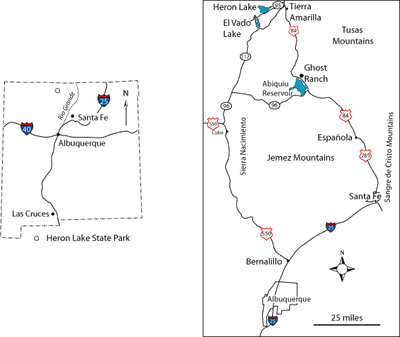
Introduction
Heron Dam was built on Willow Creek near its confluence with the Rio Chama in 1971. This earth fill dam, which is 276 feet tall and 1221 feet long, is designed to create a reservoir to store and deliver San Juan-Chama Project water. The water is used to maintain the recreation pool at Cochiti Lake, some 120 miles downstream on the Rio Grande (Figure 2). The San Juan-Chama Project, managed by the Bureau of Reclamation, takes water from tributaries of the San Juan River, which lies to the west of the Continental Divide, to augment the natural flow of the Rio Grande, which is east of the Continental Divide. The water flows through the Azotea Tunnel under the Continental Divide to Willow Creek, then to Heron Reservoir and the Rio Chama, a tributary of the Rio Grande. The diversions began in 1970, delivering an annual average of 94,200 acre-feet of water to the Rio Grande. Water users include the City of Albuquerque, the City of Santa Fe, the Middle Rio Grande Conservancy District, and the U.S. Department of Energy. The lake can hold 399,980 acre-feet at a crest elevation of 7,192 feet. Heron Lake State Park has been designated a "quiet lake", where boats travel at "no-wake" speeds.
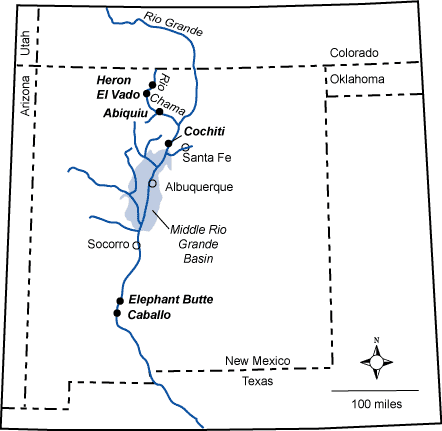
Geology
Good outcrops of the Cretaceous Burro Canyon Formation and the Dakota Formation can be seen downstream of Heron Dam (Figure 3). The oldest rock unit exposed at the surface in the park is the Jurassic Morrison Formation, which is exposed along the Rio Chama just downstream of the dam.
The Burro Canyon Formation consists of cross-bedded medium to fine-grained sandstone, quartz and chert pebble conglomerate, and pale-green to pale-red mudstones (Ridgley, 1977; Ridgley 1987; Owen et al., 2005). The unit was deposited by braided streams flowing across a coastal plain towards the northeast to north, toward the Western Interior Seaway. This unit is about 100 to 125 million years old (Owen et al., 2005; Varney, 2005).
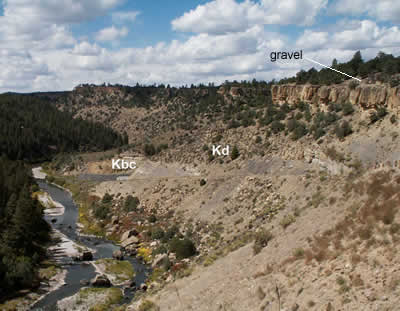
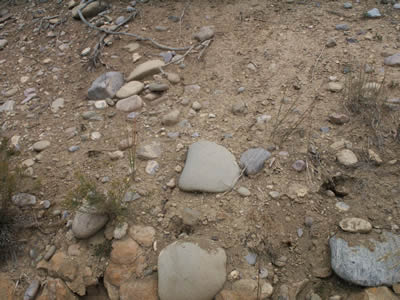
The rocks exposed along the shores of Heron Lake are predominately Late Cretaceous coastal plain, shoreline and marine units that were deposited along the western margin of the Western Interior Seaway. The Dakota Sandstone is composed of interbedded tan- to yellow brown-weathering sandstone and dark gray carbonaceous shale and siltstone. Ripple marks on tops of sandstone beds are common. The sandstones are locally cross-bedded, but, in general, the sandstones were intensely burrowed by marine organisms living in the shallow water along the shores of the Western Interior Seaway (Figures 5 and 6). Burrows are structures in sedimentary rocks formed by organisms digging or moving through sediment when the sand or mud was soft; organisms burrow through sediments seeking shelter, protection, or food. The Dakota Sandstone records the alternating rise (shale) and fall (sandstones) of sea level as the shoreline moved back and forth across the area~ 98 to 100 million years ago.
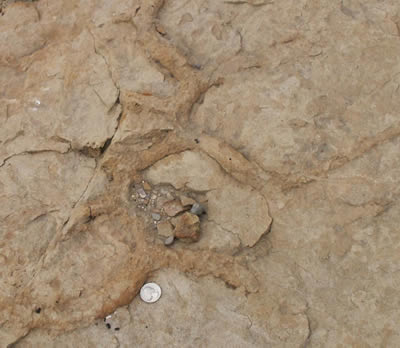
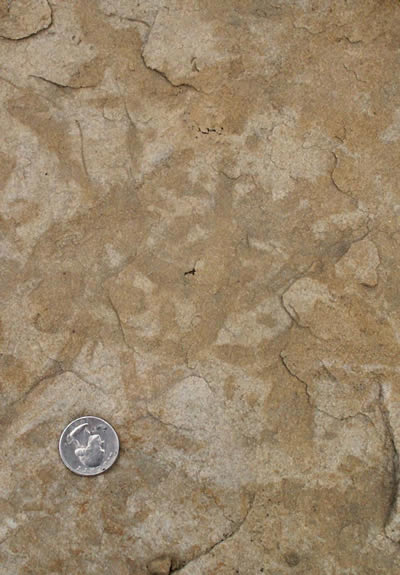
Gradual, long-term rise in sea level deposited rocks of the Mancos Group, which, from oldest to youngest, include the Graneros Shale, Greenhorn Limestone, Carlile Shale, and Niobrara Formation (Figures 7 and 8). These units are mostly made of limy muds deposited on a shallow ocean floor about 98 to 83 million years ago. Gradually sea level dropped again and the shoreline retreated to the northeast, leading to the deposition of the Mesaverde Group. The Mesaverde Group caps the mesas around Heron Lake. The Mesaverde Group consists of alternating sandstone, siltstone and coal deposited by rivers flowing into the shallow sea. Heron Lake lies at the eastern margin of the San Juan Basin, a large structural basin in northwestern New Mexico that developed during compressional Laramide deformation starting about 75 to 80 million years ago (Cather, 2004). Shortly after Laramide deformation began, the sea retreated toward the northeast one final time. The geologic record between Late Cretaceous and Quaternary time is missing in this area. The youngest rocks in the area are Quaternary colluvium and landslide deposits and ancient and modern Rio Chama river gravels (Figures 3 and 4).
The area around Heron Lake is cut by north to northeast-trending faults (Bingler, 1968; Figure 7). The Heron dam site is built on the northeast flank of the North El Vado Dome, a simple elliptical dome about 1.5 miles in diameter. A well was drilled into this dome in 1933 to a depth of 347 feet; the well was a dry hole (Fassett et al., 1977).
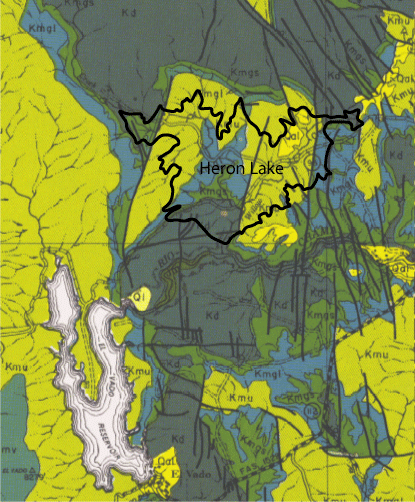
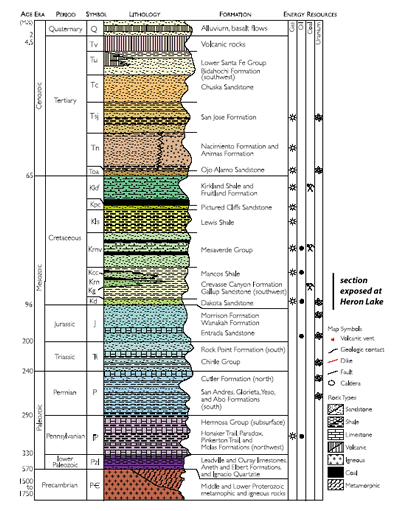
References
- Bingler, E.C., 1968, Geology and mineral resources of Rio Arriba County, New Mexico Bureau of Mines and Mineral Resources Bulletin 91, 158 pp.
- Brister, B. S. and Price, L.G., 2002, New Mexico's Energy, Present and Future— Policy, Production, Economics, and the Environment: New Mexico Bureau of Geology and Mineral Resources Decision-Makers Field Guide, San Juan Basin, p. 152.
- Cather, S.M., 2004, The Laramide orogeny in central and northern New Mexico and southern Colorado, in Mack, G.H., and Giles, K.A., eds., The Geology of New Mexico, A Geologic History: New Mexico Geological Society Special Publication 11, p. 203-248.
- Fassett, J.E., Black, B.A., Jentgen, R.W, and Osterhoudt, 1977, Third day road log from El Vado Lake to Farmington via Dulce, Lumberton, Chromo, Ignacio, Colorado, Navaho Dam and Aztec: New Mexico Geological Society Guidebook 28, p. 39-55.
- Owen, D.E., 2005, Dams and lakes of the Chama Basin area: New Mexico Geological Society Guidebook 56, p. 15-16.
- Owen, D.E., Forgas, A.M., Miller, S.A., Stelly, R.J., and, Owen, D.E., Jr., 2005, Surface and subsurface stratigraphy of the Burro Canyon formation, Dakota Sandstone, and intertongued Mancos Shale of the Chama Basin: New Mexico Geological Society Guidebook 56, p. 218-226.
- Ridgley, J.L., 1977, Stratigraphy and depositional environments of Jurassic to Cretaceous sedimentary rocks in the southwestern part of the Chama Basin, New Mexico: New Mexico Geological Society Guidebook 28, p. 153-158.
- Ridgley, J.L., 1987, Surface to subsurface cross sections showing correlation of the Dakota Sandstone, Burro Canyon (?), Formation, and upper part of the Morrison Formation in the Chama-El Vado area, Chama Basin, Rio Arriba County, New mexico: U.S. Geological Survey Map MF1496-D, 2 sheets.
- Varney, P., 2005, Dakota outcrop geology and sequence stratigraphy, Chama Basin, New Mexico: New Mexico Geological Society Guidebook 56, p. 193-217.


